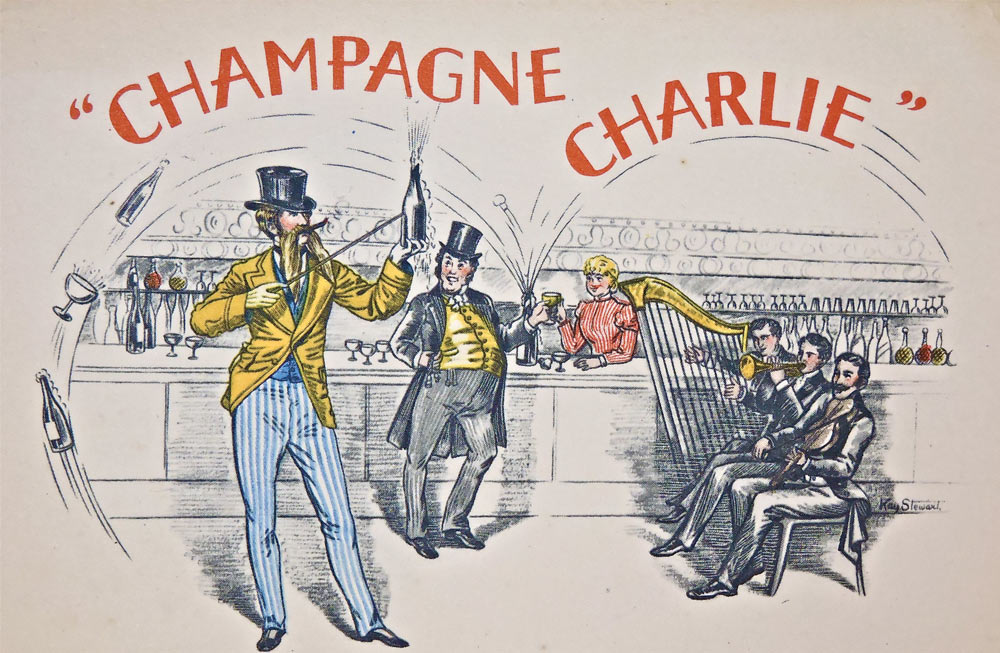Then & There: Champagne Charlie and something to cheer about

By Richard Hooper
It is the drink of New Year’s Eve and ever has it been associated with celebrations and revelry — and, on more than one occasion, scandalous behavior. It is, of course, Champagne.
While such scandal usually involved actions arising after too many toasts, there is the curious situation known as the Heidsieck Incident. It began, not from drinking Champagne, but from not paying for it and evolved to accusations of espionage against one of the most popular people in America.
In the mid-1800s, Champagne producers were seeking new markets to equal or exceed those of England and Russia, the two largest importers. A new world needed to be conquered, and Charles Heidsieck believed that new world might just be America.
Heidsieck thus became the first producer to venture forth to the United States. In 1852, he traveled through New England and New York promoting his Champagne. His efforts were not disappointing: Americans loved the stuff.
He retained an agent, returned to France and began exporting large shipments to the U.S.
Five years later, Heidsieck accompanied 300,000 bottles of Champagne to America, receiving a hero’s welcome at every stop. He was a darling of the press and became known as Champagne Charlie.
On his third trip, Champagne Charlie brought not just Champagne, but also the most recent examples of rifles and pistols created by the best French gunsmiths. He sold Champagne, hunted, was feted at banquets and participated in a cattle roundup. At a slave auction, he was appalled by the debasement of fellow human beings.
After nine months’ travel, Heidsieck returned to France and was there when the American Civil War began. A large portion of his inventory was in America, now a perilous repository. There were thousands of bottles of Champagne for which, although sold, he had not been paid.
Under very different circumstances, Champagne Charlie returned to America. His first stop was to his agent in New York to secure payment. A law had been passed that absolved Northerners of any debts owed to Southern cotton merchants.
Unfortunately for Champagne Charlie, the agent took the liberty of extending that law to refuse payment to a shocked Heidsieck.
Much of the Champagne had been distributed to Louisiana, and Heidsieck thought that merchants there might pay him. A difficult journey through a warring nation brought him to New Orleans. There was no money there.
Instead, he was offered cotton, which was loaded onto two blockade-runners at Mobile, Alabama. If he could get the cotton to Europe, there would be some recompense and a respite for his financial troubles.
After the blockade-runners set sail, the best route for Heidsieck’s return to France was to go back through New Orleans and then make his way to Mexico or Cuba where he could board a ship home. Before leaving Mobile, the French consul there gave Heidsieck a diplomatic pouch to deliver to his counterpart in New Orleans. Paying for the four-day steamboat passage by tending bar, Heidsieck arrived at New Orleans on May 5, 1862.
The city had just come under the control of the Union Army and the boat was immediately boarded by troops. The diplomatic pouch was searched and found to contain an offer from France to provide uniforms to the Confederacy.
Champagne Charlie, the toast of America a few short years before, was arrested as a spy. Diplomatic relations between America and France were cracked.
The commander of the Union Army, Gen. Benjamin Butler, thought that Heidsieck should be hanged. Instead, he spent over six months imprisoned.
Surrounded by swamp and subjected to unsanitary conditions, the presence of yellow fever and other diseases contributed to a rapid decline in his health. His financial turmoil was a catalyst that sped it on its course.
The first cotton-laden blockade-runner had been sunk early on, but Charlie hoped that the second would make its way through. It was while imprisoned that he learned the cargo of the second had also been destroyed. In France, his business was bankrupt and his wife was selling off assets to cover debts.
High-level negotiations secured his release in the middle of November, but his health had deteriorated to the point that he could not return to France until spring. When he did, he was broke.
Winter came again, bringing the cold, the snow and a messenger, a missionary from America, who delivered a packet of papers to Charles Heidsieck. They were deeds to about a third of Denver, and they were from the brother of his New York agent. Ashamed at his brother’s refusal to pay Heidsieck what he was owed, they would hopefully make amends for the brother’s chicanery.
And, they did. Heidsieck sold the deeds and restarted his business. Rejuvenated, he lived another 30 years.
So, CHEERS! May your New Year’s resolution be this salubrious. ML
Acknowledgement to “Champagne: How the World’s Most Glorious Wine Triumphed Over War and Hard Times” by Don and Petie Kladstrup.
Richard Hooper is an antiquarian book expert in Middleburg. He is also the creator of Chateaux de la Pooch, elegantly appointed furniture for dogs and home. He can be contacted at [email protected].


